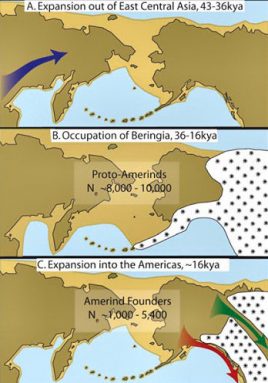Settling the Americas
Scientists have a new theory about when and how people first migrated from Asia to the New World.
By Emily Sohn
The world was a very different place tens of thousands of years ago. People didn’t yet inhabit many regions that are crowded today. Scientists have long wondered exactly when people first journeyed far from their homelands to settle all around our globe. The migration route from Asia to the Americas has proved especially mysterious. A new study provides some insight into that route.
Until recently, most researchers thought people moved from Asia into the Americas in waves, beginning about 16,000 years ago. The new study, however, suggests that migrants from Asia arrived at the northwest edge of North America as early as 40,000 years ago. Then, they had to wait for a long time for ice to melt before they could head south into the rest of the continent.
 |
|
These three maps illustrate scientists’ new model for how people first migrated from Asia into the Americas.
|
| A. Kitchen, M. Miyamoto, and C.J. Mulligan |
The new conclusions come from analyses of DNA, the genetic material that is passed from generation to generation. DNA changes, or mutates, between each generation. So, by looking at how much DNA two groups of people share today, scientists can figure out when the ancestors of those groups last lived together.
Scientists from the University of Florida in Gainesville looked at DNA taken from two groups of modern people: eastern Asians and Native Americans. The researchers used a new technique to figure out not just when the groups split but also how large the population was at different times throughout history.
About 43,000 years ago, results suggest, several hundred people left a harsh environment in what is now eastern Asia. From there, these hardy travelers trekked through Siberia and into a region called Beringia.
Today, Beringia is covered by a body of water called the Bering Strait. At the time the proposed migration began, though, Beringia was a grassy strip of land that connected Siberia with present-day Alaska.
When the travelers got to Beringia, the scientists propose, they had to stop because two huge ice sheets blocked their way. So, they waited for 20,000 years until the ice melted, about 16,000 years ago. During the long wait, the population grew to about several thousand.
“Beringia wasn’t paradise, but the new settlers survived,” says lead researcher Connie J. Mulligan. “When the North American ice sheets started to melt and passage into the New World opened, we think they left Beringia to go to a better place.”
Between 1,000 and 5,400 settlers quickly moved south when the ice disappeared, Mulligan proposes. The population grew quickly after that. Previous studies had suggested that no more than 100 people originally settled in the Americas.
Scientists have never found archaeological evidence of these first Americans, even though they maintained a stable population for a long period. In view of the new findings, that’s not surprising. Since Beringia now lies underwater, Mulligan suspects that any remains they left behind are now buried at sea.
Going Deeper:
Bower, Bruce. 2008. New World stopover: People may have entered the Americas in stages. Science News 173(Feb. 16):102. Available at http://www.sciencenews.org/articles/20080216/fob8.asp .
Gramling, Carolyn. 2007. A long trek to Asia. Science News for Kids (April 11). Available at http://www.sciencenewsforkids.org/articles/20070411/Note2.asp .
Sohn, Emily. 2006. Stone Age sole survivors. Science News for Kids (Jan. 11). Available at http://www.sciencenewsforkids.org/articles/20060111/Note2.asp .







